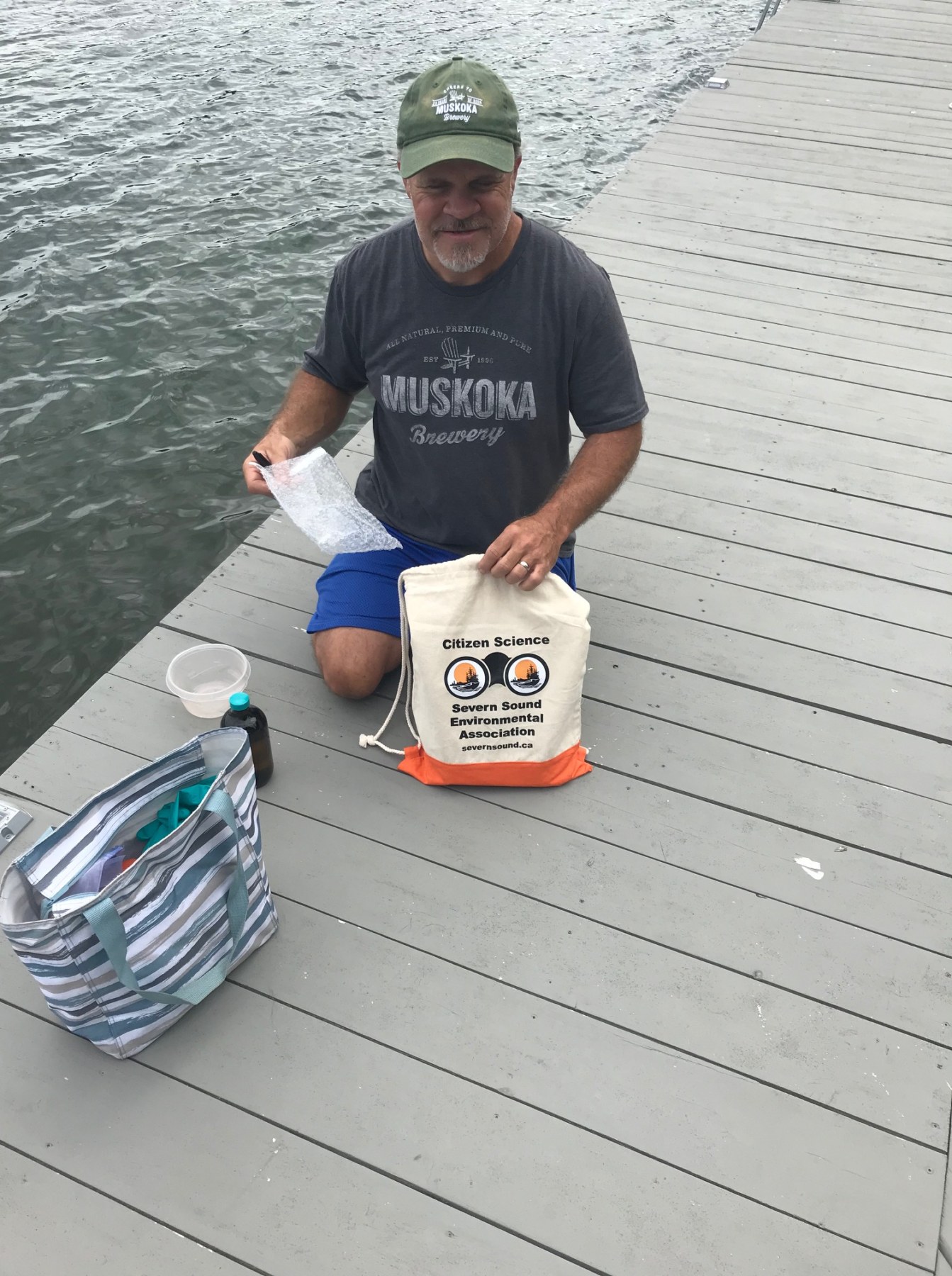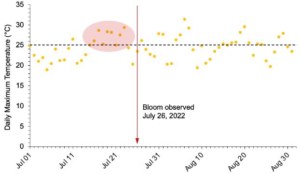Blue Green Algae in Farlain Lake
Blue Green Algae Bloom in 2022
 As the Farlain Lake community will no doubt remember, there was a blue-green algae bloom on the lake in 2022, which lasted from late July until the end of September. SSEA discovered the bloom while water quality sampling and notified the Ministry of Environment, Conservation and Parks and the Simcoe Muskoka District Health Unit. A water quality advisory was issued, and residents were told not to enter the lake, use lake water for domestic purposes, or allow pets to enter the lake.
As the Farlain Lake community will no doubt remember, there was a blue-green algae bloom on the lake in 2022, which lasted from late July until the end of September. SSEA discovered the bloom while water quality sampling and notified the Ministry of Environment, Conservation and Parks and the Simcoe Muskoka District Health Unit. A water quality advisory was issued, and residents were told not to enter the lake, use lake water for domestic purposes, or allow pets to enter the lake.Blue Green Algae Causation Study 2023
 The following detailed report outlining the results of the study was prepared by SSEA’s Sarah Song, Algae Causation Study Assistant and Aisha Chiandet, Water Scientist/Limnologist.To read the full report, available soon, visit: https://www.severnsound.ca/resources/reports-publications/.
The following detailed report outlining the results of the study was prepared by SSEA’s Sarah Song, Algae Causation Study Assistant and Aisha Chiandet, Water Scientist/Limnologist.To read the full report, available soon, visit: https://www.severnsound.ca/resources/reports-publications/.
Algae are an essential component of lake ecosystems and should always be present, however concerns arise when potentially harmful species are dominant, or when algae is present in large amounts. Recent documentation of a cyanobacteria, or blue-green algae, bloom in Farlain Lake in 2022, and observations among residents that algae are more abundant than they used to be, have contributed to a growing concern about the future impacts of algal blooms in lakes in the Severn Sound area.
The Severn Sound Environmental Association, with funding from the Township of Tiny, initiated an algae causation study in May 2023 to investigate the cause of the blue-green algal blooms in Farlain Lake. Information on the occurrence of algae, or on how abundances and species vary through the seasons, among years, or between different lakes is critical to better inform stewardship and management recommendations. This study is a first step in building that essential information.
Study Approach
The general study approach consisted of:
-
- Introducing the use of handheld fluorometers in water sampling to measure the amount of algae and blue-green algae;
- Initiating a citizen science program aimed at collecting water samples to track relationships between nearshore and offshore algae growth and various environmental factors such as wind, rainfall, and air/water temperature;
- Quantifying annual and seasonal trends in water quality;
- Determining if water quality and/or algal communities and abundances are changing relative to previous years;
- Measuring bottom water dissolved oxygen and sampling sediments for nutrient analysis to determine the importance of lake sediments as a nutrient source;
- Analyzing historical climate and water quality data; and
- Determining factors that likely contributed to bloom events.
The study included the use of a weight-of-evidence approach using field fluorometers to provide an estimate of the amount of algae and early warning of potential blooms, along with an analysis of factors known to lead to the growth of algae and cyanobacteria. The technical report presents the data collected and analyzed in 2023 as well as historical data. As more data is gathered over multiple years, a relationship between algal abundance, as measured using the fluorometers, will be easier to identify.
A significant cyanobacterial bloom was not observed on Farlain Lake in 2023, creating a challenge in assessing results from the study, which was based on detecting blooms with fluorometers and examining relationships with environmental conditions. However, key patterns were observed in both 2023 and 2022 that could potentially explain bloom conditions on Farlain Lake.
Factors Influencing Blue-Green Algal Blooms on Farlain Lake
Based on the citizen science data collected in 2023 and our analysis of SSEA water quality data from 2022 and past, we concluded that the cause of the 2022 bloom in Farlain Lake was most likely a combination of factors:
- Climate factors including significant rain events greater than 25 mm (and likely associated nutrient runoff) along with higher surface water and air temperatures, which created ideal conditions for blue-green algal growth. Periods of heavy rainfall and higher surface water and air temperatures were noted before the bloom event in 2022 (Figure 1 and 2) and potential bloom events in 2023.
 Figure 1. Total daily rainfall in July and August 2022 from SSEA’s Lafontaine weather station. |
 Figure 2. Total daily maximum temperature in July and August 2022 from SSEA’s Lafontaine weather station. |
3. Lastly, there may have been increased exposure of lake sediments to sufficiently high light levels, which can favour the growth of one of the species involved in the 2022 bloom (Gloeotrichia) since it begins its lifecycle on the lake bottom.
These conclusions align with scientific research showing that climate factors and light levels can create favourable conditions for cyanobacterial blooms. However, it is crucial to recognize the interconnected role of nutrients from shoreline inputs in amplifying these factors. Heavy rainfall can transport nutrients, such as phosphorus and nitrogen, from the shoreline into the lake. The combination of climate conditions and nutrient inputs from human activities increases the risk of harmful algal blooms. This relationship highlights the effects of shoreline activities on overall water quality and blue-green algal growth on Farlain Lake. Recognizing the importance of human influences on the lake’s ecology emphasizes the critical role of implementing effective management strategies.
Recommendations
To maintain a healthy lake ecosystem and based on the findings from this study, the SSEA recommends:
• Landowners and shoreline users implement best-practices on the lake to mitigate nutrient inputs. This includes proper care, use and maintenance of septic systems, planting or maintaining native vegetation along the shoreline and in vulnerable areas, avoiding the use of fertilizers on lawns, etc.;
• Stewardship and educational programs to promote shoreline stewardship and improve shoreline naturalization;
• Continued annual sampling through SSEA’s existing citizen science programs, Inland Lake Monitoring Program, and the Ministry of Environment, Conservation and Parks Lake Partner Program to monitor the lake’s health;
• Continued use of handheld fluorometers in SSEA monitoring programs to provide early warning signs for potential cyanobacterial blooms;
• The feasibility of implementing a voluntary fertilizer ban for shoreline properties and backlots should be investigated, including determining a setback distance, with the future option of an enforceable ban depending on property owner compliance and on how the lake responds.
• The Township of Tiny is currently having a shoreline alteration by-law drafted for Georgian Bay shoreline properties focusing on dynamic beaches. The Township will look into the feasibility of having the by-law also apply to inland lakes within the Township.
For more information on recommendations to maintain a healthy lake, visit SSEA’s website.
We thank the Township of Tiny for funding this work and the volunteers who participated in the algae monitoring program last summer, along with those who have provided ice observations through SSEA’s Ice Spotters program. Your contributions were crucial to our understanding of the lake!
